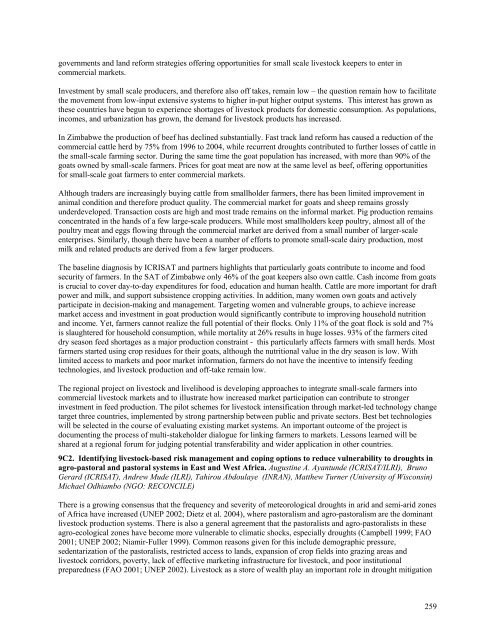ICRISAT Archival Report 2006 - The seedlings of success in the ...
ICRISAT Archival Report 2006 - The seedlings of success in the ...
ICRISAT Archival Report 2006 - The seedlings of success in the ...
You also want an ePaper? Increase the reach of your titles
YUMPU automatically turns print PDFs into web optimized ePapers that Google loves.
governments and land reform strategies <strong>of</strong>fer<strong>in</strong>g opportunities for small scale livestock keepers to enter <strong>in</strong><br />
commercial markets.<br />
Investment by small scale producers, and <strong>the</strong>refore also <strong>of</strong>f takes, rema<strong>in</strong> low – <strong>the</strong> question rema<strong>in</strong> how to facilitate<br />
<strong>the</strong> movement from low-<strong>in</strong>put extensive systems to higher <strong>in</strong>-put higher output systems. This <strong>in</strong>terest has grown as<br />
<strong>the</strong>se countries have begun to experience shortages <strong>of</strong> livestock products for domestic consumption. As populations,<br />
<strong>in</strong>comes, and urbanization has grown, <strong>the</strong> demand for livestock products has <strong>in</strong>creased.<br />
In Zimbabwe <strong>the</strong> production <strong>of</strong> beef has decl<strong>in</strong>ed substantially. Fast track land reform has caused a reduction <strong>of</strong> <strong>the</strong><br />
commercial cattle herd by 75% from 1996 to 2004, while recurrent droughts contributed to fur<strong>the</strong>r losses <strong>of</strong> cattle <strong>in</strong><br />
<strong>the</strong> small-scale farm<strong>in</strong>g sector. Dur<strong>in</strong>g <strong>the</strong> same time <strong>the</strong> goat population has <strong>in</strong>creased, with more than 90% <strong>of</strong> <strong>the</strong><br />
goats owned by small-scale farmers. Prices for goat meat are now at <strong>the</strong> same level as beef, <strong>of</strong>fer<strong>in</strong>g opportunities<br />
for small-scale goat farmers to enter commercial markets.<br />
Although traders are <strong>in</strong>creas<strong>in</strong>gly buy<strong>in</strong>g cattle from smallholder farmers, <strong>the</strong>re has been limited improvement <strong>in</strong><br />
animal condition and <strong>the</strong>refore product quality. <strong>The</strong> commercial market for goats and sheep rema<strong>in</strong>s grossly<br />
underdeveloped. Transaction costs are high and most trade rema<strong>in</strong>s on <strong>the</strong> <strong>in</strong>formal market. Pig production rema<strong>in</strong>s<br />
concentrated <strong>in</strong> <strong>the</strong> hands <strong>of</strong> a few large-scale producers. While most smallholders keep poultry, almost all <strong>of</strong> <strong>the</strong><br />
poultry meat and eggs flow<strong>in</strong>g through <strong>the</strong> commercial market are derived from a small number <strong>of</strong> larger-scale<br />
enterprises. Similarly, though <strong>the</strong>re have been a number <strong>of</strong> efforts to promote small-scale dairy production, most<br />
milk and related products are derived from a few larger producers.<br />
<strong>The</strong> basel<strong>in</strong>e diagnosis by <strong>ICRISAT</strong> and partners highlights that particularly goats contribute to <strong>in</strong>come and food<br />
security <strong>of</strong> farmers. In <strong>the</strong> SAT <strong>of</strong> Zimbabwe only 46% <strong>of</strong> <strong>the</strong> goat keepers also own cattle. Cash <strong>in</strong>come from goats<br />
is crucial to cover day-to-day expenditures for food, education and human health. Cattle are more important for draft<br />
power and milk, and support subsistence cropp<strong>in</strong>g activities. In addition, many women own goats and actively<br />
participate <strong>in</strong> decision-mak<strong>in</strong>g and management. Target<strong>in</strong>g women and vulnerable groups, to achieve <strong>in</strong>crease<br />
market access and <strong>in</strong>vestment <strong>in</strong> goat production would significantly contribute to improv<strong>in</strong>g household nutrition<br />
and <strong>in</strong>come. Yet, farmers cannot realize <strong>the</strong> full potential <strong>of</strong> <strong>the</strong>ir flocks. Only 11% <strong>of</strong> <strong>the</strong> goat flock is sold and 7%<br />
is slaughtered for household consumption, while mortality at 26% results <strong>in</strong> huge losses. 93% <strong>of</strong> <strong>the</strong> farmers cited<br />
dry season feed shortages as a major production constra<strong>in</strong>t - this particularly affects farmers with small herds. Most<br />
farmers started us<strong>in</strong>g crop residues for <strong>the</strong>ir goats, although <strong>the</strong> nutritional value <strong>in</strong> <strong>the</strong> dry season is low. With<br />
limited access to markets and poor market <strong>in</strong>formation, farmers do not have <strong>the</strong> <strong>in</strong>centive to <strong>in</strong>tensify feed<strong>in</strong>g<br />
technologies, and livestock production and <strong>of</strong>f-take rema<strong>in</strong> low.<br />
<strong>The</strong> regional project on livestock and livelihood is develop<strong>in</strong>g approaches to <strong>in</strong>tegrate small-scale farmers <strong>in</strong>to<br />
commercial livestock markets and to illustrate how <strong>in</strong>creased market participation can contribute to stronger<br />
<strong>in</strong>vestment <strong>in</strong> feed production. <strong>The</strong> pilot schemes for livestock <strong>in</strong>tensification through market-led technology change<br />
target three countries, implemented by strong partnership between public and private sectors. Best bet technologies<br />
will be selected <strong>in</strong> <strong>the</strong> course <strong>of</strong> evaluat<strong>in</strong>g exist<strong>in</strong>g market systems. An important outcome <strong>of</strong> <strong>the</strong> project is<br />
document<strong>in</strong>g <strong>the</strong> process <strong>of</strong> multi-stakeholder dialogue for l<strong>in</strong>k<strong>in</strong>g farmers to markets. Lessons learned will be<br />
shared at a regional forum for judg<strong>in</strong>g potential transferability and wider application <strong>in</strong> o<strong>the</strong>r countries.<br />
9C2. Identify<strong>in</strong>g livestock-based risk management and cop<strong>in</strong>g options to reduce vulnerability to droughts <strong>in</strong><br />
agro-pastoral and pastoral systems <strong>in</strong> East and West Africa. August<strong>in</strong>e A. Ayantunde (<strong>ICRISAT</strong>/ILRI), Bruno<br />
Gerard (<strong>ICRISAT</strong>), Andrew Mude (ILRI), Tahirou Abdoulaye (INRAN), Mat<strong>the</strong>w Turner (University <strong>of</strong> Wiscons<strong>in</strong>)<br />
Michael Odhiambo (NGO: RECONCILE)<br />
<strong>The</strong>re is a grow<strong>in</strong>g consensus that <strong>the</strong> frequency and severity <strong>of</strong> meteorological droughts <strong>in</strong> arid and semi-arid zones<br />
<strong>of</strong> Africa have <strong>in</strong>creased (UNEP 2002; Dietz et al. 2004), where pastoralism and agro-pastoralism are <strong>the</strong> dom<strong>in</strong>ant<br />
livestock production systems. <strong>The</strong>re is also a general agreement that <strong>the</strong> pastoralists and agro-pastoralists <strong>in</strong> <strong>the</strong>se<br />
agro-ecological zones have become more vulnerable to climatic shocks, especially droughts (Campbell 1999; FAO<br />
2001; UNEP 2002; Niamir-Fuller 1999). Common reasons given for this <strong>in</strong>clude demographic pressure,<br />
sedentarization <strong>of</strong> <strong>the</strong> pastoralists, restricted access to lands, expansion <strong>of</strong> crop fields <strong>in</strong>to graz<strong>in</strong>g areas and<br />
livestock corridors, poverty, lack <strong>of</strong> effective market<strong>in</strong>g <strong>in</strong>frastructure for livestock, and poor <strong>in</strong>stitutional<br />
preparedness (FAO 2001; UNEP 2002). Livestock as a store <strong>of</strong> wealth play an important role <strong>in</strong> drought mitigation<br />
259

















